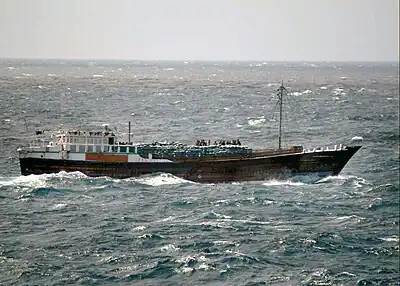Piracy in the 21st century
Piracy in the 21st century (commonly known as modern piracy) has taken place in a number of waters around the world, including the Gulf of Guinea, Strait of Malacca, Sulu and Celebes Seas, Indian Ocean, and Falcon Lake.
Waters
Caribbean
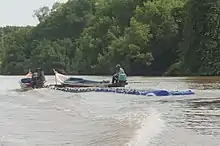
Due to the crisis in Bolivarian Venezuela, issues of piracy returned to the Caribbean in the 2010s, with the increase of pirates being compared to piracy off the coast of Somalia due to the similar socioeconomic origins.[1] In 2016, former fishermen became pirates, appearing in the state of Sucre, with attacks happening daily and multiple killings occurring.[2] By 2018 as Venezuelans became more desperate, fears arose that Venezuelan pirates would spread throughout Caribbean waters.[1] Many could have turned to piracy due to larger ships from other countries entering a Low Income Country's (LIC), (for example Somalia) water's for resources such as fish and most of the people living in LIC's have jobs as fishermen. Eventually, the larger ships will leave 'permanently' because of the lack of fish and the fishermen won't have any income to gain.
Falcon Lake
Piracy on Falcon Lake involves crime at the border between the United States and Mexico on Falcon Lake. The lake is a 100-kilometre-long (60 mi) reservoir constructed in 1954 and is a known drug smuggling route.[3]
A turf war between rival drug cartels for control of the lake began in March 2010 and has led to a series of armed robberies and shooting incidents. All of the attacks were credited to the Los Zetas cartel and occurred primarily on the Mexican side of the reservoir but within sight of the Texas coast. The so-called pirates operate "fleets" of small boats designed to seize fishermen and smuggle drugs.[4][5]
While the events have been referred to colloquially as piracy, all the waters of Falcon Lake are considered either US or Mexican territorial waters and therefore are not technically piracy under Article 101 of the UN Convention on the Law of the Sea.[6]
Gulf of Guinea
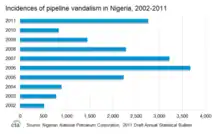
Piracy in the Gulf of Guinea affects a number of countries in West Africa as well as the wider international community. By 2011, it had become an issue of global concern.[7][8] Pirates in the Gulf of Guinea are often part of heavily armed criminal enterprises, who employ violent methods to steal oil cargo.[9] In 2012, the International Maritime Bureau, Oceans Beyond Piracy and the Maritime Piracy Humanitarian Response Program reported that the number of vessels attacks by West African pirates had reached a world high, with 966 seafarers attacked during the year.[10]
Piracy in the Gulf of Guinea has evolved over the first decade of the century. For some time, smaller ships shuttling employees and materials belonging to the oil companies with any involvement in oil exploration had been at risk in Nigeria. Over time, pirates became more aggressive and better armed.[8] As of 2014, pirate attacks in West Africa mainly occur in territorial waters, terminals and harbours rather than in the high seas. This incident pattern has hindered intervention by international naval forces. Pirates in the region operate a well-funded criminal industry, which includes established supply networks. They are often part of heavily armed and sophisticated criminal enterprises, who increasingly use motherships to launch their attacks. The local pirates' overall aim is to steal oil cargo. As such, they do not attach much importance to holding crew members and non-oil cargo and vessels for ransom. Additionally, pirates in the Gulf of Guinea are especially noted for their violent modus operandi, which frequently involves the kidnapping, torture and shooting of crewmen. The increasingly violent methods used by these groups is believed to be part of a conscious "business model" adopted by them, in which violence and intimidation plays a major role.[9]
By 2010, 45 and by 2012 120 incidents were reported to the UN International Maritime Organization.[7] However, many events go unreported. Piracy acts interfere with the legitimate trading interests of the affected countries that include Benin, Togo, Côte d’Ivoire, Ghana, Nigeria, and the Democratic Republic of Congo. As an example, trade of Benin's major port, the Port of Cotonou, was reported in 2012 to have dropped by 70 percent.[8] The cost of piracy in the Gulf of Guinea due to stolen goods, security, and insurance has been estimated to be about $2 billion.[7] According to the Control Risks Group, pirate attacks in the Gulf of Guinea had by mid-November 2013 maintained a steady level of around 100 attempted hijackings in the year, a close third behind Southeast Asia.[11]
Indian Ocean
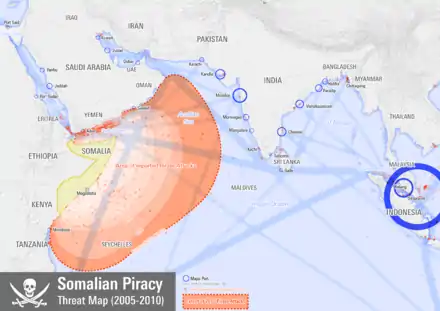
Piracy in the Indian Ocean has been a threat to international shipping since the beginning of the Somali Civil War in the early 1990s.[12] Since 2005, many international organizations have expressed concern over the rise in acts of piracy.[13][14] Piracy impeded the delivery of shipments and increased shipping expenses, costing an estimated $6.6 to $6.9 billion a year in global trade according to Oceans Beyond Piracy (OBP).[15] According to the German Institute for Economic Research (DIW), a veritable industry of profiteers also arose around the piracy. Insurance companies significantly increased their profits from the pirate attacks as insurance companies hiked rate premiums in response.[16]
Combined Task Force 150, a multinational coalition task force, took on the role of fighting the piracy by establishing a Maritime Security Patrol Area (MSPA) within the Gulf of Aden and Guardafui Channel.[17] By September 2012, the heyday of piracy in the Indian Ocean was reportedly over.[18] According to the International Maritime Bureau, pirate attacks had by October 2012 dropped to a six-year low, with only one ship attacked in the third quarter compared to thirty-six during the same period in 2011.[19] By December 2013, the US Office of Naval Intelligence reported that only 9 vessels had been attacked during the year by the pirates, with zero successful hijackings.[20] Control Risks attributed this 90% decline in pirate activity from the corresponding period in 2012 to the adoption of best management practices by vessel owners and crews, armed private security on board ships, a significant naval presence, and the development of onshore security forces.[21]
Strait of Malacca
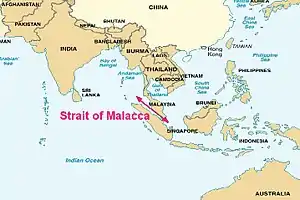
Pirates in the Strait of Malacca near Indonesia are normally armed with guns, knives, or machetes. The pirates in this area also attack ships during the night. If vessels sound an alarm, the pirates usually leave without confronting the crew.[22] Pirates in the Singapore Straits attack at night, while ships are underway or anchored.[22]
According to the Control Risks Group, pirate attacks in the Strait of Malacca had by mid-November 2013 reached a world high, surpassing those in the Gulf of Guinea.[11]
Sulu and Celebes Seas

The Sulu and Celebes Seas, a semi- enclosed sea area and porous region that covers an area of space around 1 million square kilometres,[23] have been subject to illegal maritime activities since the pre-colonial era[24] and continue to pose a maritime security threat to bordering nations up to this day. Recently, the abduction of crew members is the most common illicit activity, with most of the incidents being ascribed to the violent extremist group Abu Sayyaf. Since March 2016, the Information Sharing Centre (ISC) of the Regional Cooperation Agreement on Combating Piracy and Armed Robbery against Ships in Asia (ReCAAP) reports a total of 86 abuctions,[25] leading to the issue of a warning for ships transpassing the area.[26]
Notable occurrences
| Image | Flag (owner) | Name (class) | Crew (cargo) | Status | Date of attack | Coordinates |
|---|---|---|---|---|---|---|
| Date of release | Ransom demanded | |||||
| Dilruba (Fishing) |
unknown (unknown) |
Attacked | February 2001 | unknown | ||
| n/a | n/a | |||||
| Boarded off Patharghata. In a gun fight leaving one crew member wounded, the pirates stole supplies worth $139,373. | ||||||
| Lingfield (Tanker) |
unknown (classified) |
Attacked | March 7, 2001 | unknown | ||
| n/a | n/a | |||||
| Attacked near Bintan, Indonesia and boarded by eight pirates who, after tying up and blindfolding the ship's three senior officers, stole $11,000 from the ship's safe. | ||||||
| Jasper (Cargo) |
unknown (unknown) |
Attacked | March 9, 2001 | unknown | ||
| n/a | n/a | |||||
| Looted of $11,000 off the coast of Kosichang, Thailand by what was suspected to be members of a Thailand organized crime organization. | ||||||
| Inabukwa (Cargo) |
unknown (unknown) |
Attacked | March 15, 2001 | unknown | ||
| (2 weeks later) | n/a | |||||
| Boarded off the coast of Malaysia and, after marooning the crew on a nearby uninhabited island, the pirates escaped with the ship's cargo of tin ingots and pepper valued at $2,170,000. The ship was recovered by Filipino authorities two weeks later, following the arrest of the pirates. | ||||||
| Marine Universal (Cargo) |
unknown (unknown) |
Attacked | May 2001 | unknown | ||
| n/a | n/a | |||||
| Boarded by four pirates while at an anchorage in Lagos Harbor, Nigeria. Armed with long knives, they took one sailor hostage, and later threw him overboard. | ||||||
.jpg.webp) Infrared photograph of the Maersk Alabama while it was being hijacked |
Maersk Alabama (Cargo) |
23 (17,000 metric tons) |
Hostages rescued | 2009-04-08 | unknown | |
| 2009-04-12 | n/a | |||||
| Boarded by four pirates while en route to Mombasa, who attacked from another hijacked vessel. After a prolonged struggle with the crew, the pirates escaped the ship via lifeboat with the captain, Richard Phillips. Philips was rescued from the lifeboat three days later by US Navy SEALs, who killed three pirates. A fourth pirate, Abduwali Muse, was detained and convicted of hijacking and kidnapping in the United States. | ||||||
| MV Prantalay 11, 12, and 14 (Commercial fishing boat) |
unknown (unknown) |
Hijacked | 2010 | unknown | ||
| n/a | n/a | |||||
| The attack took place near the EEZ of India; however, the pirates took the boats and fisherman back to Somalia. The pirates held them for ransom until they received what they had asked for. | ||||||
| MSC Melody (Cruise ship) |
unknown (unknown) |
Attacked | 2009 | unknown | ||
| n/a | n/a | |||||
| About 800 kilometres (500 mi) off the coast of Somalia, pirates tried to attack an Italian cruise ship carrying nearly 1,500 people in 2009. An Israeli security team had been contracted to protect the cruise liner. Security personnel returned fire when the pirates started firing at the ship. The presence of a security team caused the pirates to turn around and abandon the attack. | ||||||
| SY Quest (Sail boat) |
unknown (unknown) |
Hijacked | 2011 | unknown | ||
| n/a | n/a | |||||
| In February 2011 Somali pirates killed four American hostages. The pirates hijacked a sail boat from the Arabian Sea and took the people aboard hostage, including a retired couple from California. When the US Navy got too close, the pirates panicked and shot the hostages. A navy spokesperson said they did not understand why the hostages would be killed, when the pirates' motive is to hold hostages for ransom. | ||||||
See also
References
- Freeman, Colin (23 May 2018). "Piracy returns to Caribbean as Venezuela turmoil spurs rise in attacks on yachts". The Telegraph. ISSN 0307-1235. Retrieved 25 May 2018.
- "El flagelo de la piratería marítima llega a las costas de Venezuela". Infobae (in Spanish). 8 December 2016. Retrieved 25 May 2018.
- "Conspiracy theories linger in Falcon Lake Mexican 'pirates' shooting", The Christian Science Monitor.
- Drug Wars in Tamaulipas: Cartels vs. Zetas vs. Military, Mexi data.
- "Mexican pirates attack Texas fishermen Falcon Lake, which straddles border", The Washington Post, May 29, 2010.
- "SECTION 4. CONTIGUOUS ZONE, Article 33". UNCLOS PART VII – GENERAL PROVISIONS. United Nations. Retrieved 2014-11-17.
- Baldauf, Scott (2012-02-28). "Next pirate hot spot: the Gulf of Guinea". The Christian Science Monitor. Retrieved 2012-02-29.
- "UN says piracy off Africa's west coast is increasing, becoming more violent". The Washington Post. Associated Press. 2012-02-27. Retrieved 2012-02-29.
- "Insight: Piracy - Gulf of Guinea". Skuld. Archived from the original on 16 January 2014. Retrieved 14 January 2014.
- Cowell, Alan (18 June 2013). "West African Piracy Exceeds Somali Attacks, Report Says". The New York Times. Retrieved 19 October 2013.
- "RiskMap 2014 Report". Control Risks Group. Archived from the original on 16 January 2014. Retrieved 14 January 2014.
- Khan, Sana Aftab. "Tackling Piracy in Somali Waters: Rising attacks impede delivery of humanitarian assistance". UN Chronicle. United Nations Department of Public Information, Outreach Division. Archived from the original on 2007-11-15.
- "Piracy: orchestrating the response". International Maritime Organization.
- "Hijackings cut aid access to south Somalia, lives at risk". World Food Programme. Archived from the original on 2010-04-01. Retrieved 2015-02-14.
- Anna, Bowden. "The Economic Cost of Somali Piracy 2011" (PDF). Oceans Beyond Piracy.
- "The Advantage of Piracy". German-foreign-policy.com. Retrieved 17 December 2011.
- Commander, Combined Maritime Forces Public Affairs (29 September 2008). "Combined Task Force 150 Thwarts Criminal Activities". US Africa Command. Archived from the original on 6 December 2008. Retrieved 17 November 2008.
- Abdi Guled, Jason Straziuso (25 September 2012). "AP IMPACT: Party seems over for Somali pirates". AP. Archived from the original on 29 July 2013. Retrieved 3 October 2012.
- Alaric Nightingale, Michelle Wiese Bockmann (22 October 2012). "Somalia Piracy Falls to Six-Year Low as Guards Defend Ships". Bloomberg News. Archived from the original on October 24, 2012. Retrieved 25 October 2012.
- Yanofsky, David (27 December 2013). "Somali piracy was reduced to zero this year". Quartz. Retrieved 14 January 2014.
- "Somali piracy is down 90 per cent from last year". The Journal. 15 December 2013. Retrieved 14 January 2014.
- Piracy and Armed Robbery Against Ships; ICC International Maritime Bureau; January 1–December 31, 2013; retrieved 4-11-2014.
- Alverdian, Indra; Joas, Marko; Tynkkynen, Nina (2020). "Prospects for multi-level governance of maritime security in the Sulu-Celebes Sea: lessons from the Baltic Sea region". Australian Journal of Maritime & Ocean Affairs. 12 (2): 114. doi:10.1080/18366503.2020.1770944. S2CID 219931525.
{{cite journal}}: CS1 maint: multiple names: authors list (link) - Ikrami, Hadyu (2018). "Sulu-Sulawesi Seas Patrol: Lessons from the Malacca Straits Patrol and Other Similar Cooperative Frameworks". The International Journal of Marine and Coastal Law. 33 (4): 800. doi:10.1163/15718085-12334092. S2CID 158983060.
- Safety 4 Sea (15 January 2021). "ReCAAP ISC: 2020 ends with 97 piracy incidents in Asia, a 17% increase". Safety 4 Sea. Retrieved 7 August 2021.
- RECAAP ISC (2020). "Annual Report. January- December 2020". Retrieved 6 August 2021.
{{cite journal}}: Cite journal requires|journal=(help)
External links
- Live Piracy Map. Recent piracy incidents listed by the Piracy Reporting Centre of the International Maritime Bureau.
